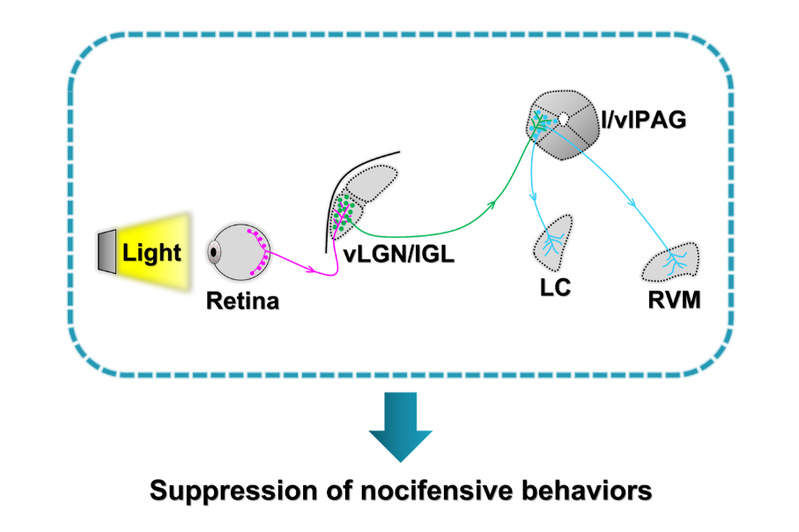Prof. Chaoran Ren`s group published an article entitled `A visual circuit related to the periaqueductal gray area for the antinociceptive effects of bright light treatment` in the latest issue of Neuron. They identified a visual circuit related to the periaqueductal gray (PAG) which underlies the antinociceptive effects of bright light treatment.

Light is a powerful modulator of non-image-forming functions, including mood, cognition, and pain. Prof. Ren`s team endeavors to endeavors to elucidate the circuit mechanisms of the non-image-forming functions of light. In previous studies, they gradually deciphered the circuit mechanisms underlying the anti-depressive and spatial-memory-promoting effects of BL treatment and identified an indispensable role of ventral lateral geniculate nucleus and intergeniculate leaflet (vLGN/IGL)-related visual circuits in mediating the effects of LT on both depressive-like behaviors and spatial memory (Neuron, 2019; 2021).

The retina-vLGN/IGL-l/vlPAG pathway underlies the antinociceptive effects of bright light
In the latest study, they demonstrate that bright light treatment suppresses mouse nocifensive behaviors through a di-synaptic visual circuit connecting the retina and the lateral and ventral lateral parts of the PAG (l/vlPAG). Specifically, they find that a subset of retinal ganglion cells (RGCs) innervates GABAergic neurons in the vLGN/IGL, which in turn inhibit GABAergic neurons in the l/vlPAG. The activation of vLGN/IGL-projecting RGCs, activation of l/vlPAG-projecting vLGN/IGL neurons, or inhibition of postsynaptic l/vlPAG neurons is sufficient to suppress nocifensive behaviors. Finally, they demonstrate that the antinociceptive effects of bright light treatment are dependent on the activation of the retina-vLGN/IGL-l/vlPAG pathway.
Together, these findings reveal a neural circuit in mice that conveys the antinociceptive effects of bright light, which may improve our understanding of the structure and function of the non-image-forming system and provide novel insights into the neuronal mechanism underlying the antinociceptive effects of bright light treatment
Besides Prof. Ren, contributors to this work include Zhengfang Hu, Yiman Mu, Lu Huang, Yuqing Hu, Zhiqing Chen, Yan Yang, Xiaodan Huang, Yunwei Fu, Yue Xi, Song Lin, Qian Tao, Fuqiang Xu and Kwok-Fai So. This work was funded by several grants including the National Natural Science Foundation of China and National Key Research and Development Program of China.
Link
https://doi.org/10.1016/j.neuron.2022.02.009
Highlighted by Nature Reviews Neuroscience `Shining a light on pain` https://doi.org/10.1038/s41583-022-00590-9
Highlighted by National Natural Science Foundation of China
https://www.nsfc.gov.cn/publish/portal0/tab876/info84406.htm


